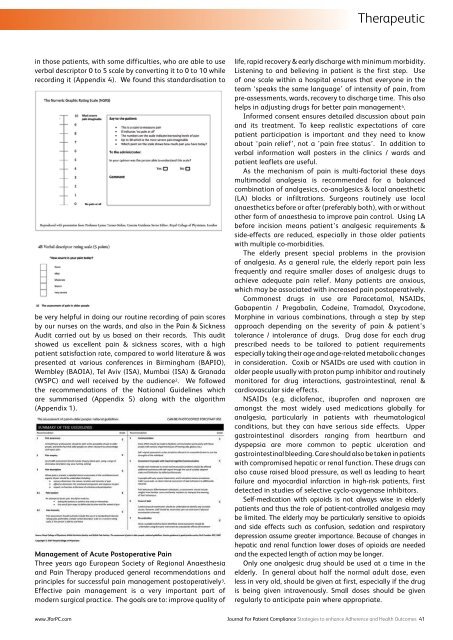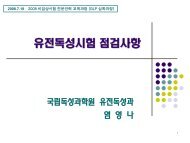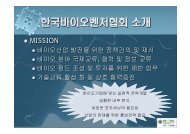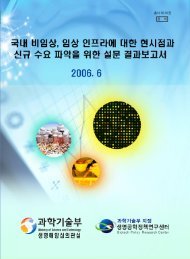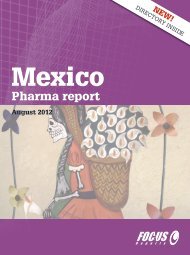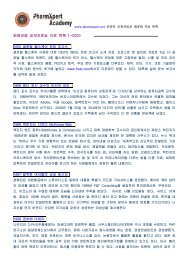PATIENT COMPLIANCE - PharmXpert Academy
PATIENT COMPLIANCE - PharmXpert Academy
PATIENT COMPLIANCE - PharmXpert Academy
Create successful ePaper yourself
Turn your PDF publications into a flip-book with our unique Google optimized e-Paper software.
Therapeuticin those patients, with some difficulties, who are able to useverbal descriptor 0 to 5 scale by converting it to 0 to 10 whilerecording it (Appendix 4). We found this standardisation tobe very helpful in doing our routine recording of pain scoresby our nurses on the wards, and also in the Pain & SicknessAudit carried out by us based on their records. This auditshowed us excellent pain & sickness scores, with a highpatient satisfaction rate, compared to world literature & waspresented at various conferences in Birmingham (BAPIO),Wembley (BAOIA), Tel Aviv (ISA), Mumbai (ISA) & Granada(WSPC) and well received by the audience 2 . We followedthe recommendations of the National Guidelines whichare summarised (Appendix 5) along with the algorithm(Appendix 1).Management of Acute Postoperative PainThree years ago European Society of Regional Anaesthesiaand Pain Therapy produced general recommendations andprinciples for successful pain management postoperatively 3 .Effective pain management is a very important part ofmodern surgical practice. The goals are to: improve quality oflife, rapid recovery & early discharge with minimum morbidity.Listening to and believing in patient is the first step. Useof one scale within a hospital ensures that everyone in theteam ‘speaks the same language’ of intensity of pain, frompre-assessments, wards, recovery to discharge time. This alsohelps in adjusting drugs for better pain management 4 .Informed consent ensures detailed discussion about painand its treatment. To keep realistic expectations of carepatient participation is important and they need to knowabout ‘pain relief’, not a ’pain free status’. In addition toverbal information wall posters in the clinics / wards andpatient leaflets are useful.As the mechanism of pain is multi-factorial these daysmultimodal analgesia is recommended for a balancedcombination of analgesics, co-analgesics & local anaesthetic(LA) blocks or infiltrations. Surgeons routinely use localanaesthetics before or after (preferably both), with or withoutother form of anaesthesia to improve pain control. Using LAbefore incision means patient’s analgesic requirements &side-effects are reduced, especially in those older patientswith multiple co-morbidities.The elderly present special problems in the provisionof analgesia. As a general rule, the elderly report pain lessfrequently and require smaller doses of analgesic drugs toachieve adequate pain relief. Many patients are anxious,which may be associated with increased pain postoperatively.Commonest drugs in use are Paracetamol, NSAIDs,Gabapentin / Pregabalin, Codeine, Tramadol, Oxycodone,Morphine in various combinations, through a step by stepapproach depending on the severity of pain & patient’stolerance / intolerance of drugs. Drug dose for each drugprescribed needs to be tailored to patient requirementsespecially taking their age and age-related metabolic changesin consideration. Coxib or NSAIDs are used with caution inolder people usually with proton pump inhibitor and routinelymonitored for drug interactions, gastrointestinal, renal &cardiovascular side effects.NSAIDs (e.g. diclofenac, ibuprofen and naproxen areamongst the most widely used medications globally foranalgesia, particularly in patients with rheumatologicalconditions, but they can have serious side effects. Uppergastrointestinal disorders ranging from heartburn anddyspepsia are more common to peptic ulceration andgastrointestinal bleeding. Care should also be taken in patientswith compromised hepatic or renal function. These drugs canalso cause raised blood pressure, as well as leading to heartfailure and myocardial infarction in high-risk patients, firstdetected in studies of selective cyclo-oxygenase inhibitors.Self-medication with opioids is not always wise in elderlypatients and thus the role of patient-controlled analgesia maybe limited. The elderly may be particularly sensitive to opioidsand side effects such as confusion, sedation and respiratorydepression assume greater importance. Because of changes inhepatic and renal function lower doses of opioids are neededand the expected length of action may be longer.Only one analgesic drug should be used at a time in theelderly. In general about half the normal adult dose, evenless in very old, should be given at first, especially if the drugis being given intravenously. Small doses should be givenregularly to anticipate pain where appropriate.www.JforPC.comJournal For Patient Compliance Strategies to enhance Adherence and Health Outcomes 41


